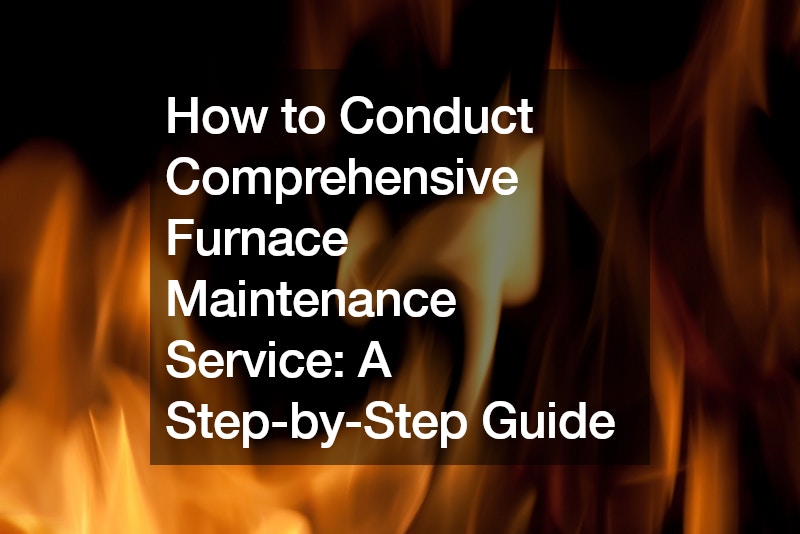
As winter approaches, ensuring your furnace is functioning efficiently becomes a top priority. A well-maintained furnace keeps your home warm and comfortable, reduces energy consumption, and prevents costly breakdowns. This comprehensive guide will equip you with the knowledge and steps to perform a thorough furnace maintenance service, keeping your heating system running smoothly all season long.
Safety First:
Before diving in, prioritize safety. Turn off the furnace at the main electrical panel and gas supply valve (if applicable).
Allow the furnace to cool completely before proceeding.
Gather Your Supplies:
Here are the tools and materials you’ll need:
Screwdriver set Vacuum cleaner with hose attachment Shop vac (optional, recommended for heavy dust) Soft brush Replacement furnace filter (refer to your owner’s manual for the correct size) Step 1: Clear the Area Around the Furnace
Remove any clutter or flammable objects from around the furnace to ensure proper airflow and prevent fire hazards.
Step 2: Replace the Air Filter
A clogged air filter is a major culprit for inefficient furnace operation. Locate the air filter compartment (usually a hinged door or a removable panel) and replace the old filter with a new one. Ensure the filter is inserted with the correct airflow direction (indicated by arrows on the filter).
Step 3: Clean the Furnace Cabinet
Use a soft brush or a vacuum cleaner with a hose attachment to remove dust and cobwebs from the exterior of the furnace cabinet. Pay attention to areas around vents and burners.
Step 4: Clean the Flue Pipe (Optional, for advanced DIYers)
The flue pipe vents combustion gases out of your home. Excessive buildup of soot or debris can hinder proper venting. Caution: Cleaning the flue pipe can be messy and requires proper safety precautions. If you’re not comfortable performing this step, consider hiring a professional HVAC technician.
Step 5: Inspect the Burner Assembly (Visually Only)
The burner assembly is where the fuel is ignited to generate heat. Do not attempt to disassemble or clean the burner assembly yourself. Visually inspect the burners for any signs of damage, corrosion, or cracks. If you notice any abnormalities, contact a qualified HVAC technician.
Step 6: Inspect the Pilot Light (Gas Furnaces Only)
Gas furnaces have a pilot light that continuously burns to ignite the main burners when needed. Look for a small flame through a viewing window on the burner assembly. If the pilot light is out or seems weak, consult your owner’s manual for relighting instructions. Important: If you’re unable to reignite the pilot light safely, turn off the gas supply valve and contact a technician.
Step 7: Test the Furnace Operation
Once you’ve completed the cleaning and inspection steps, turn the furnace back on at the main electrical panel and gas supply valve (if applicable). Reset the thermostat to heating mode and a comfortable temperature. Listen for any unusual noises during operation. If you notice any abnormal sounds, lingering odors, or malfunctions, turn off the furnace and contact a qualified HVAC technician for further evaluation.
When to Call a Professional:
While this guide provides steps for basic furnace maintenance, some tasks are best left to professionals. Here are some situations where calling a qualified HVAC technician is recommended:
You’re uncomfortable performing any of the steps yourself. You suspect major repairs might be needed (e.g., faulty burners, malfunctioning thermostat). Your furnace is old (over 10-15 years) and requires a professional inspection. You notice any signs of gas leaks (rotten egg smell). Benefits of Regular Maintenance:
Performing regular furnace maintenance offers numerous benefits:
Improved Efficiency: A clean furnace operates more efficiently, leading to lower energy bills. Reduced Risk of Breakdowns: Regular maintenance helps identify and address minor problems before they become major breakdowns. Extended Furnace Lifespan: Proper care can extend the lifespan of your furnace, saving you money on premature replacements. Enhanced Safety: Regular cleaning minimizes the risk of fire hazards and carbon monoxide leaks. Conclusion:
By performing routine maintenance and scheduling professional inspections when necessary, you can ensure your furnace keeps your home warm and comfortable throughout the winter season. Remember, a well-maintained furnace is not only essential for comfort but also saves money and promotes safety in your home. Investing a little time and effort now can prevent costly breakdowns and extend the lifespan of your furnace, ensuring years of reliable heating performance. For complex tasks or if you’re unsure about any step, don’t hesitate to call a qualified HVAC technician. Peace of mind and a warm winter are just a few steps away!.
.

